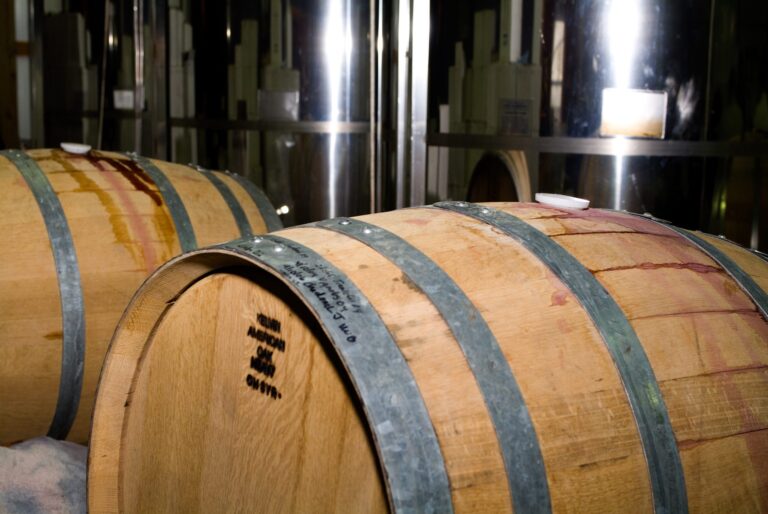
This week, I was explaining a technique I did for making “Blue My Mind 2014” to a visiting winery. We have two tanks in fermentation as I type this, and I used the same yeast in both tanks, yet there is a difference in flavor. However, there is nothing quite like experimenting with our best selling wine…for fun. Tank 1 simply tastes better at this point than tank 2. And there’s nothing wrong with tank 2. It tastes great. After we fermented our Vignoles 2014, we pumped out the wine and pumped in Chardonnay 2014 juice. When it came time to ferment the Steuben which is, for the most part, Blue My Mind, we pumped out the chardonnay and pumped in the Steuben. Did I miss a step? Did I not clean the tank? Um…nope! I didn’t add any additional yeast either! Call it spontaneous / instant fermentation. The bourbon industry, I have heard, are very protective of their yeast and will take yeast from one fermentation to the next. In the wine industry, we typically clean the daylights of our tanks before adding any new juice. Risking microbiological harm to the new fermentations are reason’s 1-99 for cleaning tanks between fermentations. The primary risk is acetic acid, AKA, vinegar. So why do it? Both the vignoles and the chardonnay had very, very clean fermentations, so I had tank full of ready to go, very dominant yeast just asking for more sugars. If there were any off strains of yeast, the ones in the tank that fermented Vignoles and Chardonnay dominated and possibly eliminated them. So why does it taste better? With all the spent yeast cells congregating at the bottom of the tank some of the yeast will break down into the wine to add complexity. So there you go. Cleanliness is key to making good wine. But sometimes a dirty tank is actually clean and has some great benefits inside it!
Barrels: This summer and fall we have been bottling short runs of our red wines aging in barrels and we have distinctly noticed that each bottling is better than the last one. The main reason for the short run bottlings is you! We’ve simply sold wine at a faster pace and I didn’t have wines to go back in the barrels. And we don’t like to leave barrels empty due to CLEANLINESS! Barrels hold up much longer and much better if they are kept clean, and full. But that’s not what this article is about. It’s about one specific benefit that barrels can provide any and all wines – concentration of flavors and aromas through evaporation. Barrels are under siege in the wine industry today, not because they don’t work. It’s just that they are expensive, and it’s very easy today to impart oaky aromas and flavors through the addition of barrel staves into stainless steel tanks. We’ve never done that, though for barrels which have lost all of their flavor, we have added new staves directly into the barrels. And I have found that I love that process, as we can really control the oak compounds leached into the wines. We can make the oak more subtle, or up-front. Or take the wines somewhere in-between. Of course we still buy new barrels, and we always will. The added oak staves gave me a fun tool to add more dimensions to our wines. But I can’t see me ever adding them to stainless steel. It’s the micro-oxidation and concentration of flavors that makes me dizzy with enjoyment. As me sometime, and I’ll pour you a current release Pinot Noir 2013 and our first bottling of the wine. Or, I can do the same with Rhapsody in Red 2013. Yeah, there’s a little more oak to the newer bottlings, but what I really notice is the concentration of fruit flavors and tannins, and perhaps a little more kick up of alcohol.
Whenever we open barrels to taste, unless we are pulling the wine out, we have to top the barrels back off with wine. And some barrels can take upwards of 5 pitchers of wine or more. Back in 2004, we studied concentration levels, and found that for our location, each barrel concentrates the alcohol percentage about a percent and a half more per year. If for instance we add a wine to a barrel at 12% on November 1st. by the next October 31st the wine is usually close to 13.5%. How is that? When it’s humid in the winery alcohol leaches through the oak staves into the atmosphere. When it’s drier in the winery, water evaporates out of the barrels at a much higher rate than alcohol and all of this evaporation subsequent refilling concentrates aroma and flavor compounds in the wines. Simple enough. And the beauty of the barrels is the lack of bad oxidative properties. When we open a barrel for tasting we hear this big ol’ “whoosh” of air rushing in. Called “ullage” in our industry, as the wine